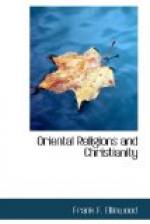With these limitations and qualifications in view, let us turn to the history of some of the leading non-Christian faiths. Looking first to India, we find in the 129th hymn of the Rig Veda, a passage which not only presents the conception of one only supreme and self-existing Being, but at the same time bears significant resemblance to our own account of the creation from chaos. It reads thus:
“In the beginning there was
neither naught nor aught,
Then there was neither atmosphere
nor sky above,
There was neither death nor
immortality,
There was neither day nor
night, nor light, nor darkness,
Only the EXISTENT ONE breathed
calmly self-contained.
Naught else but He was there,
naught else above, beyond.
Then first came darkness hid
in darkness, gloom in gloom;
Next all was water, chaos
indiscrete,
In which ONE lay void, shrouded
in nothingness."[132]
In the 121st hymn of the same Veda occurs a passage which seems to resemble the opening of the Gospel of St. John. It reads thus, as translated by Sir Monier Williams:
“Him let us praise,
the golden child that was In the beginning, who
was born the Lord, Who
made the earth and formed the sky.”
“The one born Lord” reminds us of the New Testament expression, “the only begotten Son.” Both were “in the beginning;” both were the creators of the world. While there is much that is mysterious in these references, the idea of oneness and supremacy is too plain to be mistaken. Professor Max Mueller has well expressed this fact when he said: “There is a monotheism which precedes polytheism in the Veda; and even in the invocation of their (inferior) gods, the remembrance of a God, one and infinite, breaks through the mist of an idolatrous phraseology like the blue sky that is hidden by passing clouds."[133] These monotheistic conceptions appear to have been common to the Aryans before their removal from their early home near the sources of the Oxus, and we shall see further on that in one form or another they survived among all branches of the migrating race. The same distinguished scholar traces the early existence of monotheism in a series of brief and rapid references to nearly all the scattered Aryans not only, but also to the Turanians on the North and East, to the Tungusic, Mongolic, Tartaric, and Finnic tribes. “Everywhere,” he says, “we find a worship of nature, and the spirits of the departed, but behind it all there rises a belief in some higher power called by different names, who is Maker and Protector of the world, and who always resides in heaven."[134] He also speaks of an ancient African faith which, together with its worship of reptiles and of ancestors, showed a vague hope of a future life, “and a not altogether faded reminiscence of a supreme God,” which certainly implies a previous knowledge.[135]




